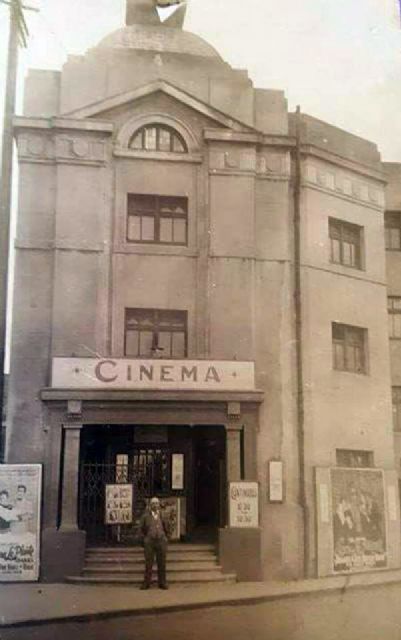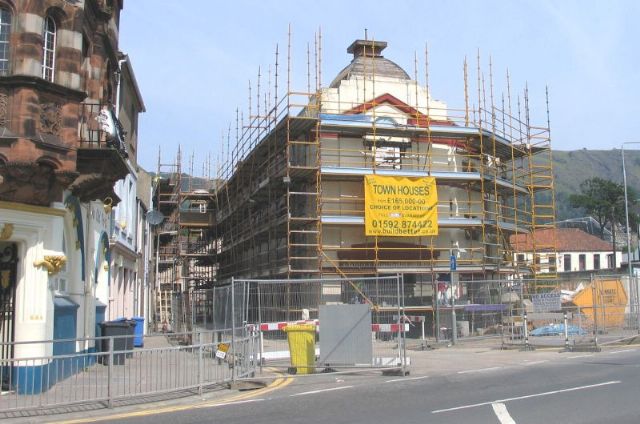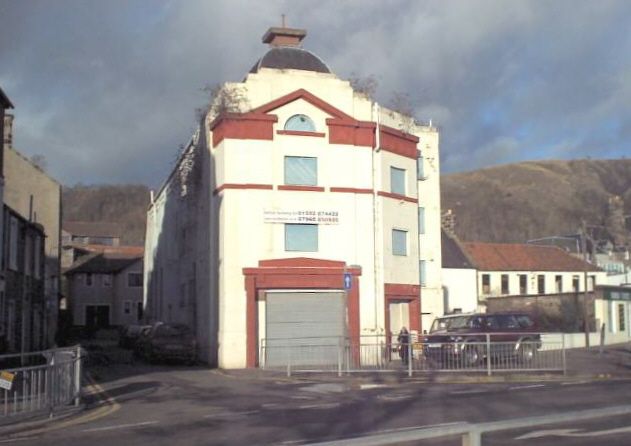The Porte Cinema
By the late Norman Mackie

Photo from the mid 1930s
The Porte Cinema had been built in 1915 by the Burntisland Cinema House Company and was managed by Mr Tom Lunn. Here too silent pictures were shown and accompanied by the resident pianist, Mrs Kinnear. Enjoyment of the Cowboys and Indians with the many serials was enhanced by the inevitable and adjacent sweet shop (Miss Stocks). Admission prices were 6d, 9d,1/3d, 1/6d (or 2.5p, 3.75p, 6.25p, 7.5p!).
In 1931 Burntisland Associated Pictures Ltd, Falkirk, took over the Burntisland Cinema House Company and on the retirement of Mr Tom Lunn, Miss A.C. Mackie became manageress and a new era began. The installation of the latest sound equipment by the British Thomson Houston Company made the innovation of talking pictures a reality in Burntisland.
The days of Al Jolson had arrived, together with Jeanette McDonald, Nelson Eddy and many other new stars. As the number of cinema goers increased and colour films became reality the Burntisland Associated Picture company looked ahead and visualised a new super deluxe Cinema in the centre of the town. It would be built to the highest standard, together with two shops.
When the new cinema opened in 1939, the Porte's life as a cinema ended. British Road Services purchased the building in 1955. Pickfords Storage Ltd. took over in the 1960s and made many internal alterations. It was sold to Salvona's in 1970. Later Mr John Cooper acquired the premises and it became an Amusement Arcade, pool and snooker club. In due course, that too closed.

During Conversion to flats
The Porte Cinema was built in 1915. It closed in 1939 on the opening of its much larger and more luxurious replacement, the new Palace Cinema at the other end of the High Street. In the 1950s and 1960s the Porte building was used for storage, notably by Pickfords, and it is still referred to locally as 'the Pickfords building'. It then served as an amusements arcade, run firstly by the Salvona family and subsequently by John Cooper. More recently, Mr Cooper sold the building to a local developer, Bob Wilkie. Before the sale, Mr Cooper did the town a service by painting the façade.
During the course of 2002, there was extensive discussion within Burntisland of Mr Wilkie's plans for the Rose Street/Thistle Street area. These involved the complete demolition of the Porte Cinema. The plans met with general approval. Although the Porte Cinema was not as great an eyesore as the Palace Cinema, it was far more prominent - and Mr Wilkie was suggesting that the cinema site could be used for a modern block of flats of significant architectural merit. So far, so good, as far as most folk were concerned.
The old cinema was not a listed building, but it was in a conservation area. However, Historic Scotland had raised no objection to the demolition plans in 2002. Then, early in 2003, they reappeared on the scene. In a remarkable U-turn, they declared that the Porte Cinema was indeed of historic significance - it was, after all, one of Scotland's first purpose built cinemas, and at the very least the façade must be retained. This caused considerable alarm in the town, because now the redevelopment scheme for the entire area was in jeopardy.
However, the interested parties got their heads together again, and Mr Wilkie produced revised plans for the area. These included the retention of the shell of the Porte Cinema, within which he would create several modern apartments. Garages would be included at ground floor level, with access from Rose Street. Again, the plans met with general approval and the development went ahead.

Before Conversion in 2004
Memories of the Porte Cinema
Writing in the Autumn 2004 issue of the Burgh Buzz, Mrs Betty Duckworth (née Johnston) of Kirkcaldy recorded her memories of the Porte: "My family had moved temporarily to a tenement house in Somerville Street when I was about ten or eleven. In the same building lived my pal of that time (Jenny Moodie). Our Saturdays were always the same. About 1.30 we made our way up Union Street and crossed over to the fruit shop directly opposite. Every week we bought the same, a ha'penny spoiled fruit and a ha'penny worth of peanut

